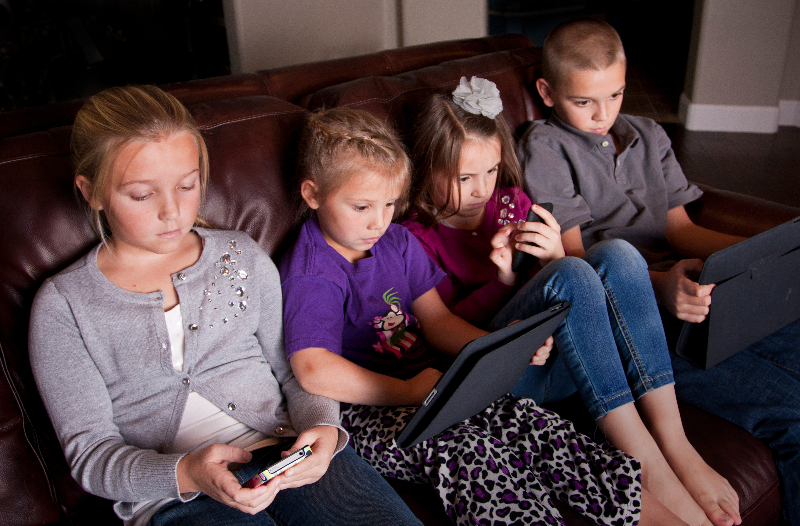Screen Time And Kids: Creating Balance To Reduce Negative Effects
Screens and digital devices are everywhere. Cell phones, laptops, and tablets are part of everyday life. Kids are even doing most of their school work on computers.
While our daily lives rely on computers and electronic devices, we’re constantly told to watch our screen use.
Today we’re going to take a deeper look at screen time and how it can affect kids. While excessive screen time can be problematic for anyone, it’s important to monitor screen use with kids because it can impact their developing brains.
This week’s blog talks about the negative effects screen time has on kids, why you might consider reducing screen time, and ways to use screen time responsibly to live a healthy, balanced life.
The Negative Effects Of Screen Time
It’s impossible to get away from screens but studies have shown that too much screen time can negatively affect people. In kids, it can often decrease the quality of their sleep, interfere with emotional regulation, and decrease academic performance.1
Poor sleep quality
Screen time directly affects sleep. With modern technology, most screens emit blue light which disrupts your circadian rhythm – also known as your sleep-wake cycle.2
Blue light from electronic devices resembles daylight which signals to the brain that it’s daytime, making you more alert. This signal to the brain decreases melatonin, a hormone that regulates your sleep-wake cycle and is essential for a good night’s sleep.3
To keep screen time from interrupting your child’s sleep, you can stop all screen use at least one hour before bedtime.
Behavioral problems and emotional dysregulation
Behavioral problems associated with screen time are different for every child. Some kids can be more sensitive to it than others but many parents find that increased screen time can have a negative impact on emotional regulation because kids have a hard time getting off the screen because their brains want more.
Excessive screen time can make kids want to stay on the screens longer and (depending on what they watch), they can develop a hyperarousal response, which increases the fight or flight response. An increased fight or flight response can create feelings of overwhelm and anxiety. 4
Knowing exactly what content your kids consume and setting appropriate screen time limits can help.
A decrease in academic performance
Many schools are opting to use laptops instead of textbooks so it might sound surprising that screen time can decrease academic performance. Every child is different and whether or not screen time affects academics depends on many different factors.
There are many computer programs and apps that help kids learn but too much screen time can cause problems with executive function skills.
Screen use may decrease the opportunity for kids to solve problems, be active, socialize, and focus on one task at a time. This can interfere with executive function skills.
Executive function skills help you:
- Plan
- Organize
- Pay attention and focus
- Increase self-control
- Stay focused despite distractions
- Manage time
Strong executive function skills are crucial to academic success. Balancing time between screen use and real-world, hands-on activities can prevent screen time from getting in the way of academic performance.
Reducing Screen Time In Your Family
Reducing screen time is great for the whole family. It gives your eyes a break from blue light and more time to be together doing other things.
Studies show a lot of great benefits from reducing screen time, such as:
- Reducing aggression
- Boosting creativity
- Being more present and “in the moment”
- Reducing stimulation
- Calming the mind
If you’re looking for ways to reduce your screen time in your family, you can:
- Listen to music
- Play an instrument
- Write in a journal
- Write poetry or short stories
- Spend time in nature
- Read a book
- Play board games
- Do puzzles
- Do arts and crafts projects
- Go to a museum
Setting limits on screen time as part of your day can help too. For example, you can incorporate a “no device” rule during meals and other family times. For any family member who has a cell phone, utilizing the phone’s do not disturb feature is a great way to limit distractions and notifications that can increase anxiety.
It’s almost impossible to get away from screens but using them responsibly can help reduce negative effects.
Use Screens Responsibly
Screens and electronic devices aren’t going anywhere. Here are some ways your family can use screens in a healthy, balanced way.
Don’t sit too close
Being close to screens can cause digital eye strain. Your children can avoid this by keeping the screen 18-24 inches from their eyes. Also, you can try the 20-20-20 rule to prevent digital eye strain. After 20 minutes of screen look away for about 20 seconds, 20 feet away.5
Create balance
Not all content is created equal. Being aware of what your kids are watching and what types of video games they are playing is important. Eliminating content that is violent, scary, and explicit can help reduce the chances of screen time negatively impacting your family. For any child who is using social media, monitoring their use and ensuring they are interacting appropriately and not being the target of cyberbullying is also important.
Alternating between screen time and non-screen activities helps create balance. Making sure screen time doesn’t get in the way of family time, healthy social interactions, homework, and sleep.
Limit screen time
It’s not the easiest to do but trying to decrease screen time to 1-2 hours of noneducational screen time and stopping screen use 1-2 hours before bed is best. This helps calm the brain and can reduce the chance of it impacting sleep.
Model healthy screen use
Modeling healthy, appropriate screen use is the best way to teach your kids to use screens. Challenge yourself to limit your own screen time. You can start by tracking how much you use screens. Most cell phones and tablets track your screen use in the settings. Start by checking to see how much you’re already using screens and set a goal to slowly decrease the amount of time you use them each day.
How Neurofeedback Can Help
If your family is feeling the negative effects of screen use, neurofeedback might be able to help.
NeurOptimal® neurofeedback promotes relaxation, healthy sleep habits, mental acuity, and focus. Neurofeedback trains the brain to work at its most optimal state, increasing neuroplasticity – your brain’s ability to adapt and change.
NeurOptimal® monitors your brain’s electrical patterns while you’re listening to music or watching a movie. When the device detects the brain is about to shift suddenly, or it detects turbulence, it’ll briefly pause – bringing you back to the present moment.
Over time, neurofeedback trains your brain to its most optimal state, helping you feel more relaxed and calm. NeurOptimal® promotes healthy lifestyle changes and is an at-home neurofeedback system that anyone can use.
With NeurOptimal®, your family can:
- Train your brain right from home
- Feel more rested, energized, and confident
- Improve mental acuity and focus
Do you have questions about neurofeedback? Do you want to talk with someone from our team?
Fill out the contact form here and we’ll get back to you as soon as possible.
Sources

